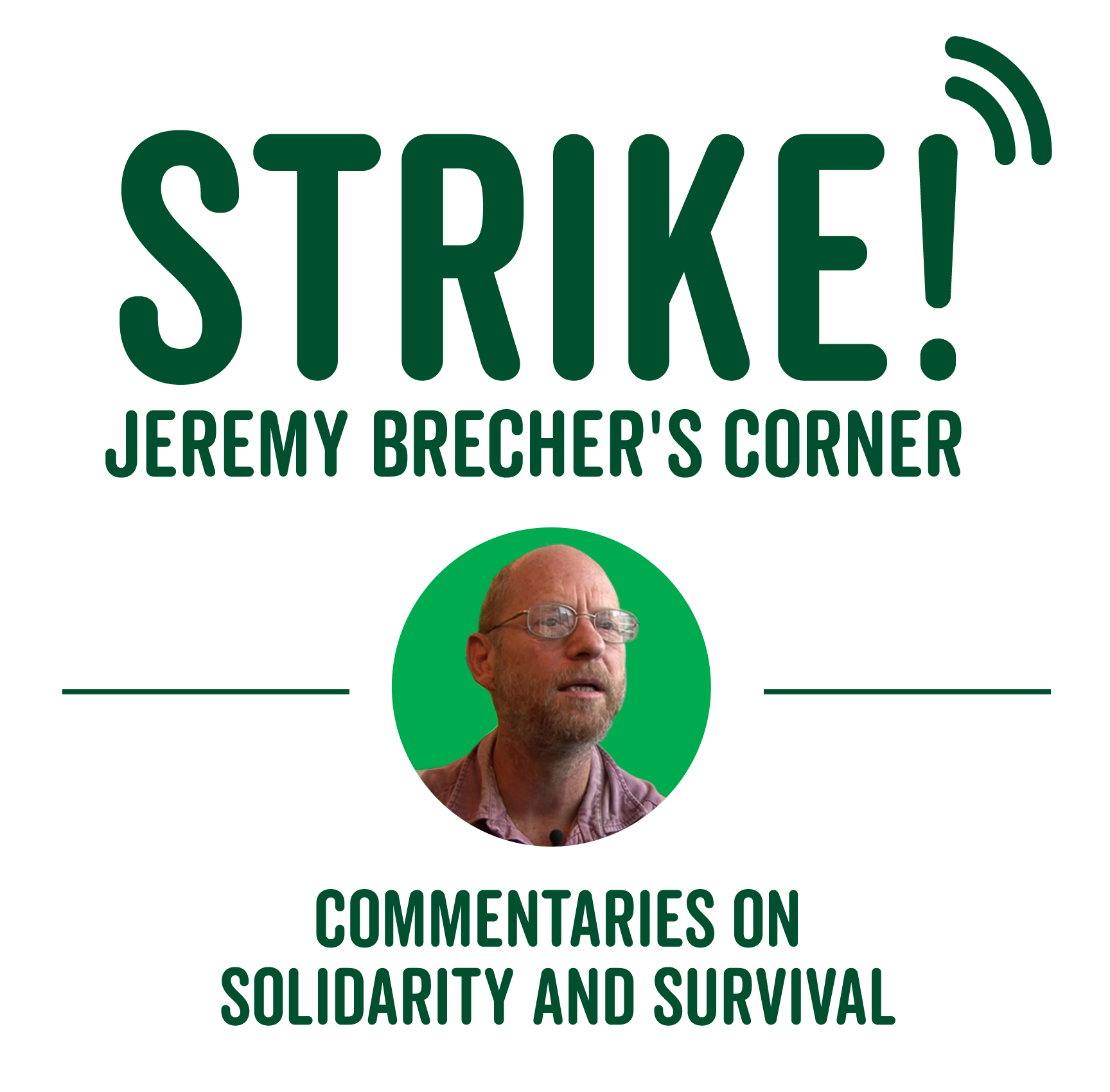Listen to the audio version >>
The COVID-19 era has confronted workers with unique threats and problems – and they have turned to unique strategies to counter them. The previous commentary, “Striking in the Coronavirus Depression,” described how workers in hundreds of workplaces conducted strikes and other forms of on-the-job action to demand safer working conditions and hazard pay in the pandemic. These were primarily self-organized wildcat strikes with little or no union backing. This commentary describes two “mini-revolts”–the Strike for Black Lives and the recent strikes and strike threats by teachers–that also show new forms of organization and action, often with union support.
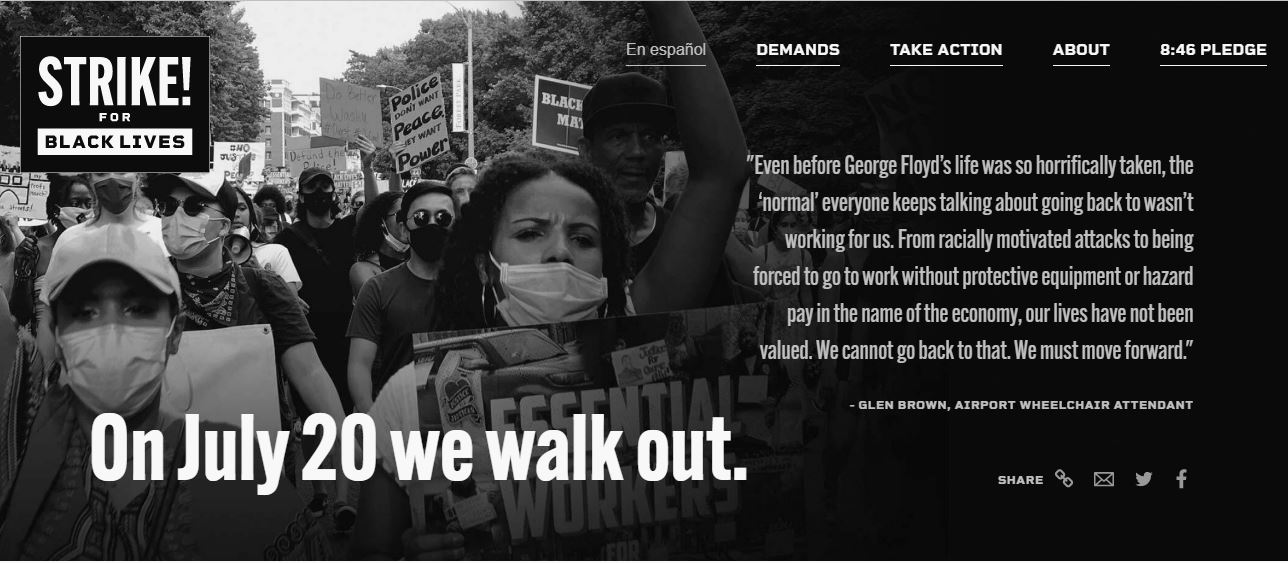
While the number of trade union strikes this year are lower than previous years, there have so far been hundreds of wildcat strikes without union authorization, primarily in the fight for worker safety amid COVID and racial justice. The Strike for Black Lives, which took place on July 20, 2020 is one such example.
Conventional trade union strikes have become rarer and rarer in the COVID-19 era. According to an analysis in Bloomberg Law, unions have been “slow to stage traditional, wide-ranging workplace strikes amid the snowballing health and economic crisis caused by the coronavirus pandemic.” Bloomberg Law’s database of work stoppages indicates that there were 23 strikes in unionized workplaces in the first quarter 2020, idling a mere 16,829 workers. These are the lowest first-quarter totals in four years.[1] There were only two strikes in April and in May, the lowest level since 1990. In the first half of 2020, unions called a record-low 33 strikes. By comparison, in the first half of 2019 they called 80.[2]
On the other hand, as we saw in the previous commentary, hundreds of wildcat strikes have occurred without union authorization. These have generally been strikes for protection of workers health and extra pay for hazardous work. In addition, there have been some large-scale actions that, while far from conventional strikes, saw unions supporting work stoppages. These include the Strike for Black Lives, the strike by professional athletes protesting racial killings, and the teachers strikes over school reopening.
Strike for Black Lives
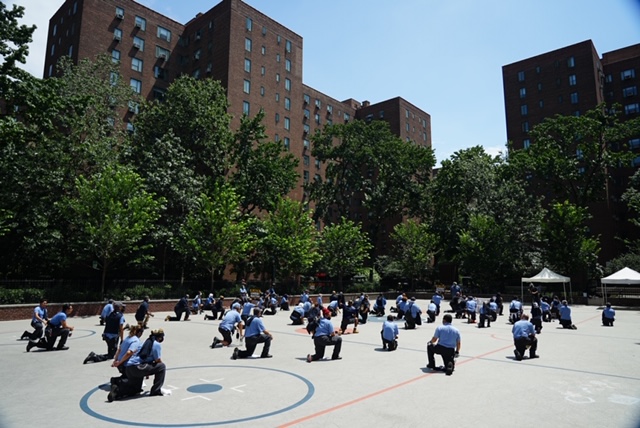
One hundred @Teamsters building service workers at Stuy Town take a knee in honor of #GeorgeFloyd with the #StrikeForBlackLives. #J20. Source: SEIU tweet.
In an action unprecedented in American labor history, on July 20 national unions and labor and political groups took part in a “Strike for Black Lives.” The action was led by the Service Employees International Union (SEIU) and the Movement for Black Lives. Union supporters included the Teamsters, the American Federation of Teachers, the United Farm Workers, the United Food and Commercial Workers, the Communications Workers of America, the Amalgamated Transit Union, and UNITE HERE.
The action focused on four demands: (1) justice for Black communities; (2) that elected officials use their authority to rewrite the rules so that Black people can thrive; (3) that corporations dismantle racism, white supremacy and economic exploitation including at work; and (4) that every worker has the opportunity to join a union.[3] Participating workers often added their own demands for better pay and COVID-19 safety measures. While some workers actually struck, organizers encouraged those who were not in a position to strike to protest in other ways, such as taking a knee, holding a moment of silence, or walking off their jobs at noon local time for 8 minutes and 46 seconds in memory of George Floyd and other victims of police violence.[4]
While organizing focused on 25 cities, actions occurred in 200. 1,500 janitors struck in San Francisco. 6,000 nurses picketed 85 nursing homes in New York, New Jersey and Connecticut. Outside a St. Louis McDonald’s, workers marched for higher wages. In Detroit they marched for better coronavirus protection. In Memphis, AT&T call center and logistics workers demonstrated. In New York, 100 UPS workers demonstrated in front of their workplace to show solidarity with the Black Lives Matter movement and to protest growing inequality. In Washington, DC strikers demonstrated at the Capitol to support the HEROES act.[5]
The unions participating had millions of members. Notably, they did not call their members out on strike, or even promise to protect them if they decided to strike on their own initiative. Nonetheless, this may be the first time in history that major American unions have called for strikes and other workplace action to affect broad social issues. Not only did the country’s second largest union (SEIU) put its muscle behind Black Lives Matter, but the Strike for Black Lives deliberately promoted the idea of workers using their workplace power as a vehicle for political action through an enlarged concept of strikes and general strikes. The action was also unusual in its spread across industries and occupations and in combining strikes with other forms of protest action.
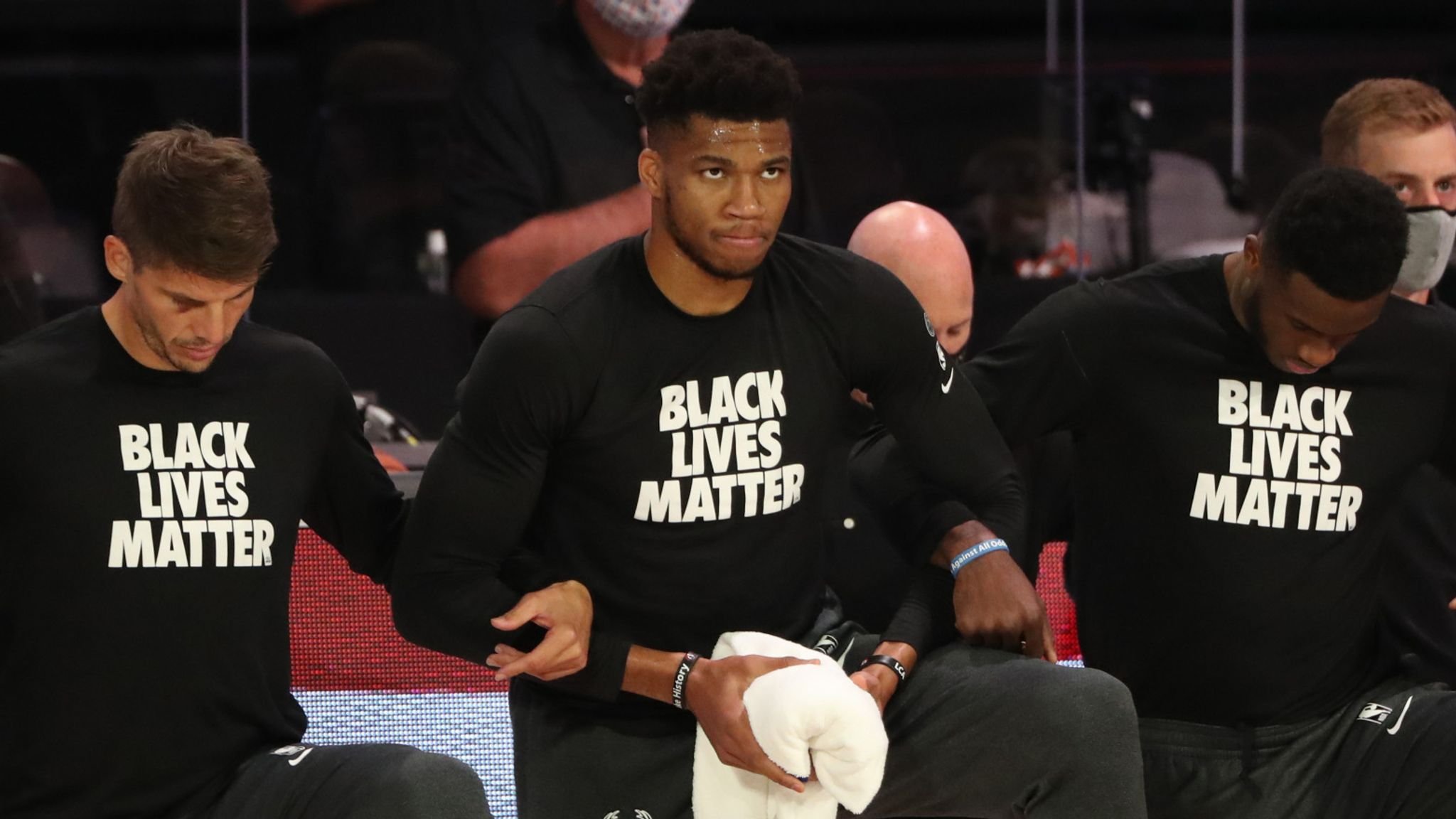
“The Bucks have decided to boycott Game 5 of the #NBAPlayoffs against the Magic in the wake of the shooting of #JacobBlake. Some things are bigger than sports. Our humanity is worth a little discomfort. Nothing but RESPECT for the @Bucks!!” Source: @MrAhmednurAli
The Strike for Black Lives had an equally unique sequel. On Sunday, August 22, police in Kenosha, Wisconsin shot Jacob Blake, a 29-year old Black man, more than six times while his children looked on. On Wednesday the 25th, the Milwaukee Bucks professional basketball team declined to show up for their scheduled game, launching what would become a nationwide strike. They read a statement calling for justice for Jacob Blake and for the Wisconsin State Legislature to “reconvene after months of inaction” and “take up meaningful measures to address issues of police accountability, brutality, and criminal justice reform.” That evening NBA players held an emergency meeting to discuss the strike, and soon all that evening’s playoff games were postponed. Soon after that the Women’s National Basketball Association decided to join them. And the strike spread so rapidly to other sports that before the day was over five major league men’s soccer games, three major league baseball games, and at least one international tennis tournament were cancelled.[6] It took the personal intervention of former president Barack Obama and a pledge to open up stadiums as voting centers in the next election to persuade the NBA players to go back to work.
Teachers
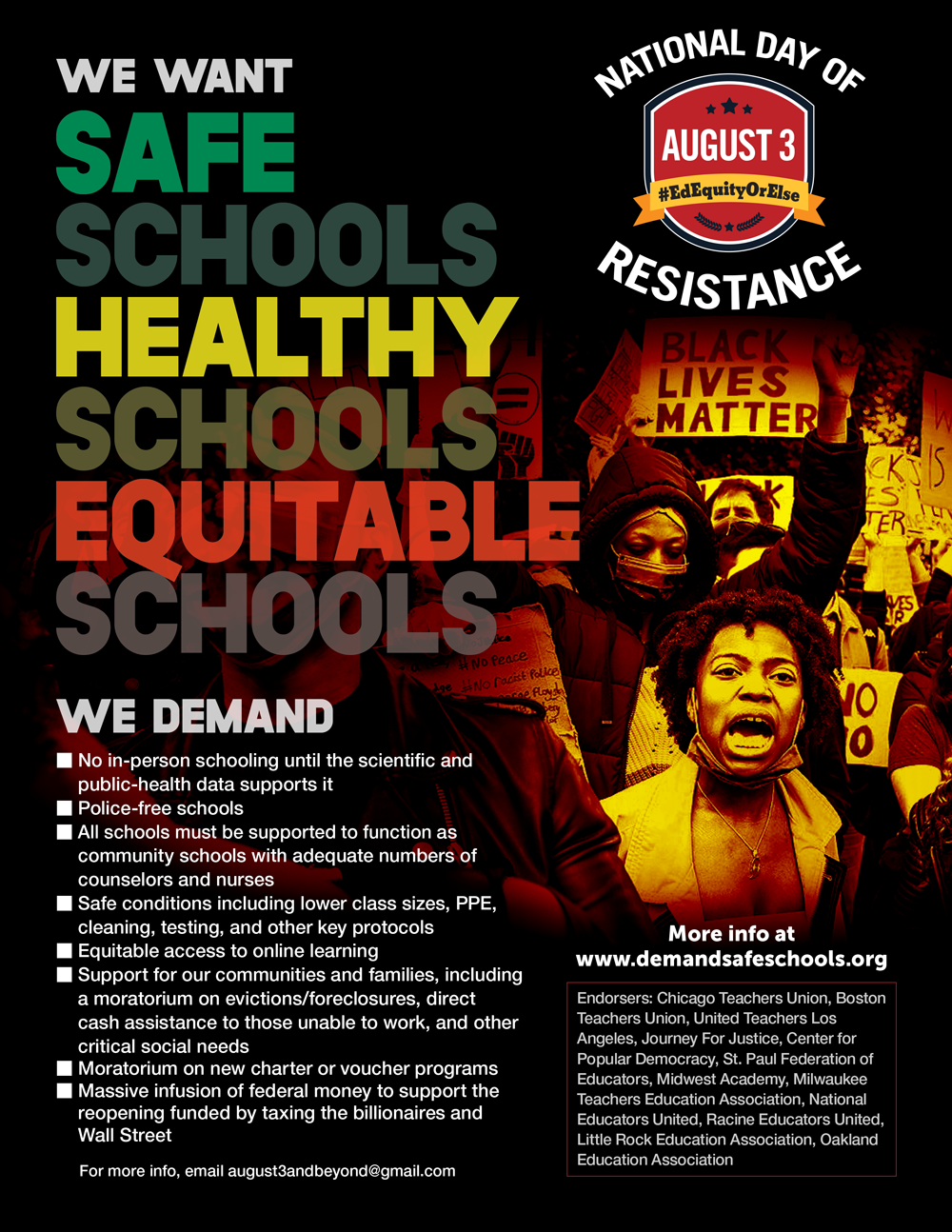
This graphic was used for the #DemandSafeSchools action that took place on August 3, 2020. There will be another day of action on September 30, 2020. Source: DemandSafeSchools.org.
The past few years have seen a swelling wave of strikes by public school teachers and other education workers. Strike for the Common Good, a forthcoming book by Rutgers professor Rebecca Kolins Givan, spells out the extent and character of this rebellion:
- 92 strikes in 21 states since January 1, 2012.
- More than 672,000 teachers walked out, affecting 6.7 million students.
- Close to half of the strikes, 42, were illegal in the state where they took place.
- More than 80 percent of the illegal strikes (35 of 42) occurred in 2018 and 2019, beginning with West Virginia.
- About 412,000 teachers participated in illegal strikes in 2018 and 2019, compared to fewer than 14,000 for the previous six years combined.
Givan says,
If there’s one thing we’ve learned since West Virginia, it’s that teachers are not afraid to walk out. Strikes are contagious. A successful strike emboldens teachers in other states, cities, and school districts, leading to more strikes and stronger demands. Teachers know that they can use their collective voice to advocate for high quality schools, whether they’re fighting for adequate funding or standing up for safety during a pandemic.[7]
Indeed, as the pandemic progressed, teachers increasingly used their power to strike to become protagonists in a local, state, and national struggle over education and health policy in the COVID-19 era — opening a new pathway for asserting a workers’ voice and challenging “management’s right to manage.”
In March, as the COVID-19 pandemic spread across the country, governors, mayors, and school districts began ordering that in-person schooling be replaced by remote on-line teaching. Teachers had limited voice in these decisions, and in response they began demanding that they be represented in the policy making process.[8] As the fall 2020 school year approached, President Donald Trump began demanding that schools reopen face-to-face. The CDC and other agencies put out standards for safe return to classrooms, but few school systems made plans that would actually meet those standards. Millions of teachers were, frankly, afraid for their lives. They began vocally opposing school reopening plans they considered unsafe and demanding that authorities negotiate with them about COVID-19 policy.
AFT Supports Safety Strikes for Teachers. Author: Bloomberg Markets and Finance.
Under pressure from their rank and file, educator unions moved toward authorizing strikes – even though they violated contracts and were illegal in most states. Late in July, the American Federation of Teachers, which represents 1.7 million school employees, took an unprecedented step: it authorized its members to strike if their schools planned to reopen without proper safety measures. AFT’s on-line national convention issued a resolution saying it will support any local that decides to strike over reopening plans. The union pledged to provide its locals financial resources, legal backing, communications support, and staffing. It said buildings should reopen only in areas with lower virus rates, and only if schools require masks, update ventilation systems, and provide for social distancing. AFT president Randi Weingarten said, “If authorities don’t protect the safety and health of those we represent and those we serve, as our executive council voted last week, nothing is off the table.” The National Education Association, the largest education union, said its members will do “whatever it takes” to protect students. President Lily Eskelsen García said, “Nobody wants to see students back in the classroom more than educators, but when it comes to their safety, we’re not ready to take any options off the table.”[9]
Monday, August 3 was a national day of action to protest opening of schools without necessary safety precautions. In Chicago, 500 teachers circled City Hall for hours in cars opposing the Chicago Public School’s plan to reopen schools under conditions the teachers considered unsafe for them and for their students. USA Today noted, “The demonstration had hallmarks of the massive strike the Chicago Teachers Union waged 10 months prior during a contract dispute with the city.”[10] The union’s vice president, Stacy Davis Gates, said, “It’s long past time for our nation’s educators to come together and fight collectively for the common good — up to and including striking to ameliorate the social and economic inequalities at the root of the consequences of this insidious virus.” Any safety strike would include broader demands to support front-line workers, to provide broadband access to every student, to ensure universal health care and to get “a hard commitment from public officials to protect Black and Brown lives, whose neighborhoods are disproportionately bearing the burden of death and illness from COVID-19.” Two days after the Chicago rally Mayor Lori Lightfoot announced that schools would reopen on-line only.
Chicago was one of the last big districts to decide to start the school year online, “a move largely driven by local teachers unions,” according to USA Today. In Columbus, Ohio, 2,700 educators signed a letter calling for schools to open on-line. Shortly thereafter the school district announced that all classes would start on-line. In San Tan Valley outside of Phoenix, the JO Combs unified school district announced it would resume in-person classes. 109 teachers and other school staff, about one-fifth of the district’s 600 staff, called in sick. In response, school reopening was canceled. “We have received an overwhelming response from staff indicating that they do not feel safe returning to classrooms with students,” said the superintendent of schools. “Due to these insufficient staffing levels, schools will not be able to reopen on Monday as planned.” [11]
New York was the only major US city still planning to bring students into physical classrooms this fall. According to the New York Times, “The pressure to change those plans mounted this week, when the city’s powerful teachers’ union was poised to authorize an illegal strike for its 75,000 members.”[12] After negotiations with the United Federation of Teachers, Mayor Bill de Blasio has postponed reopening for ten days. What will happen then remains to be seen.
Arizona kindergarten teacher and union activist Kelley Fisher told a reporter, “I’d love to see a nationwide sickout.”[13] No doubt she is not alone.[14]
Like the early years of the Great Depression, the opening of the Coronavirus Depression saw a sharp decline in conventional trade union strikes. It simultaneously saw a proliferation of wildcat strikes and walkouts, often organized by co-workers through social media as well as workplace conversations and meetings.
This summer has seen two significant national strike actions–for Black Lives and for safe reopening of schools. These are hardly conventional strikes–indeed, they represent historically unprecedented forms of protest. So far such actions have won modest police reforms and improvements in some health protections. Beyond that, they have made workers power a factor in COVID-19 and racial justice –two of the most central national issues of this era.
Listen to the audio version >>
[1] Robert Combs, “Covid-19 Has Workers Striking. Where Are the Unions?,” Bloomberg Law, April 14, 2020.
[2] Robert Combs, “Unions Find New Leverage With Social Justice Protests,” Bloomberg Law, July 24, 2020.
[3] https://j20strikeforblacklives.org/demands/
[4] Rachel Treisman, “Essential Workers Hold Walkouts And Protests In National ‘Strike For Black Lives,’” NPR, July 20, 2020
[5] Jacob Bogage, “’Strike for Black Lives’ spurs thousands of workers to walk out,” Washington Post, July 20, 2020.
[6] Claire Lampen and Hannah Gold, “Everything We Know About the Sports Strike,” New York, August 27, 2020.
[7] “35 Illegal Teacher Strikes Since 2018. Are More Coming This Month?” Rutgers School of Management and Labor Relations, August 21, 2020.
[8] For more on the early history of teacher involvement in COVID-19 policy, see Monique Dols and Peter Lamphere, “Full Steam Ahead on Reopening Schools? No Way, Say Teachers,” Labor Notes, July 21,2020.
[9] Collin Binkley, “National teacher union supports strikes over reopening plans,” ABC News, July 28, 2020.
[10] Erin Richards, “With COVID cases rising, teachers drive back-to-school reopening plans,” USA Today, August 13, 2020. For the strikes of teachers in Chicago and throughout the country over the past decade, see Jeremy Brecher Strike!, (Oakland, CA: PM Press, 2020) Chapter 11.
[11] “Calls for nationwide sickout as Arizona school district cancels reopening,” The Guardian, August 15, 2020.
[12] Troy Closson, “Why N.Y.C. Delayed the First Day of School,” New York Times, September 2, 2020. l
[13] Ibid, The Guardian, August 15, 2020.
[14] For an extensive survey of educator action on school reopening as of late August, 2020 see Barbara Madeloni, “Will Schools Open?” Labor Notes September 2020.

